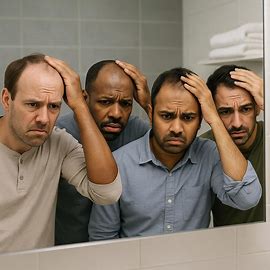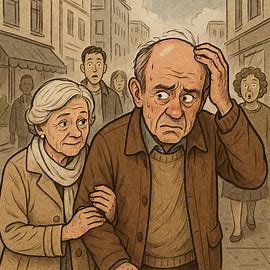(Oh My Goodness, What’s Happened to My Hair?)
Male pattern baldness, also known as androgenetic alopecia, is something that sneaks up on many of us, often without warning. It’s pretty common—around half of men will experience some degree of balding by age 50. It’s not just about hair loss; it’s about understanding why it happens and what you can do about it.
Your family tree might hold some answers to why you’re losing hair. If Grandpa sported a shiny head or Dad started thinning out in his thirties, the chances are, you’re following in their footsteps. Genetic predisposition plays a huge role, passing down that charming trait of thinning locks from one generation to the next.

Now, this might sound like a horror flick, but hair loss doesn’t happen overnight. It generally follows stages better known as the Hamilton-Norwood scale. This scale ranges from slight receding to almost complete baldness. Knowing where you land can help in figuring out what steps to take and when.
But why is it mostly guys who face the wrath of baldness? It’s largely due to how male hormones—like testosterone—affect hair follicles over time as they age. These hormones cause hair follicles to shrink, resulting in thinner hair and, eventually, none at all. Sorry, fellas—sometimes nature just doesn’t play fair! Understanding these causes gives you the knowledge you need to tackle baldness head-on.
Hormonal Influences: The Science Behind Hair Loss
Hormones play a starring role in the saga of male pattern baldness. The main villain hailed in this drama is dihydrotestosterone, or DHT. It’s a byproduct of testosterone and packs a powerful punch when it comes to hair follicles. DHT messes with the lifecycle of hair, causing thick, healthy strands to weaken and eventually vanish into thin air.
Testosterone might sound like the culprit here, but it’s the conversion of testosterone into DHT that’s the real issue. When DHT levels are high, it zeroes in on those hair follicles, shrinking them until they’re too tiny to carry on growing hair. This makes DHT a key player in the hair loss narrative.
Hormonal shifts aren’t all about permanent loss, though. They can also mess with hair growth cycles by shortening the growth phase and lengthening the resting phase, where the hair is paused instead of growing. This imbalance leads to more hair falling out and not enough growing back.
The good news? Science hasn’t given up on our heads. Researchers are working hard on hormonal treatments that might give men a break from hair loss. Medications that block DHT or balance hormone levels are showing promise, though each comes with its own pros and cons. These treatments aren’t a one-size-fits-all, but they offer hope for regaining some control over what happens up top.

Lifestyle and Environmental Factors: Beyond Genetics
While you might feel destined to follow family patterns, lifestyle choices are another big puzzle piece in balding. Stress is a sneaky contributor, ramping up those stress hormones that can send hair follicles into early hibernation. Managing stress—think yoga, meditation, or even a simple walk—might be more beneficial for your hairline than you imagine.
What you eat plays a pivotal role, too. A nutrient-rich diet supports not only your overall health but the health of your hair. Iron, zinc, and vitamins like B12 are key players in keeping those strands strong. Skipping meals or indulging too much in processed foods could fast-track hair thinning, so balance is your best friend here.
Smoking and alcohol also deserve a mention. They don’t just take a toll on your lungs or liver but can also affect blood flow to your scalp, reducing hair growth over time. Cut back where you can and your hair—and body—will thank you.
Pollutants and toxins—hello, urban living—can also play havoc with your hair. Dust, grime, and chemicals hanging in the air might contribute to those stubborn strands taking a permanent vacation. While it’s tough to control the air quality around you, keeping your scalp clean and well-nourished can help mitigate the damage of environmental factors.
Together, these lifestyle and environmental elements show that while you might not control genetics, making conscious choices can influence how, or even if, those genes manifest in your hair.
Medical Conditions and Hair Loss: When to See a Doctor
Sometimes hair loss is about more than just genetics or lifestyle. Specific medical conditions can also trigger those unwelcome changes in your hair density. Understanding these conditions can help in tackling them before they cause more permanent changes.

Alopecia areata is one of these conditions, where the immune system mistakenly attacks hair follicles, leading to patchy bald spots. It’s a less common cause but definitely one to keep in mind. Thyroid disorders, like both hyperthyroidism and hypothyroidism, can also throw hair cycles off balance, causing hair to thin out or shed more noticeably.
Spotting when your hair loss might be due to a medical problem rather than typical baldness is crucial for getting the right treatment early. If you notice rapid changes, patchiness, or additional symptoms like fatigue or weight fluctuations, it’s time to get professional advice.
Getting a firm diagnosis from a healthcare provider is half the battle won. They can do tests, identify potential underlying issues, and suggest appropriate treatments. From medications to dietary changes, or even just reassurance, the right diagnosis is essential for tailored care.
Teaming up with a doctor can demystify the process and offer a line-up of options based on your specific situation. The key is to act promptly so that treating the underlying problem can also help preserve and possibly restore some of your hair health.
Innovative Solutions and Emerging Therapies: A New Hope for Men
The world of hair restoration is expanding with a slew of options and innovations. The traditional treatments like minoxidil and finasteride have held their ground for a while. They’re often the first go-to’s for keeping hair loss at bay and might even roll back the clock a little on receding hairlines. But like any solution, they come with pros and cons, including potential side effects.
For those unafraid to explore advanced options, hair transplants offer a more permanent fix. They’ve come a long way in technology and natural-looking results. It’s no longer about those obvious hair plugs; modern techniques focus on making new growth blend seamlessly with existing hair.
Stem cell therapy and Platelet-Rich Plasma (PRP) are hot on the trail and generating buzz. These therapies aim to rejuvenate and enhance growth by harnessing the body’s own regenerative abilities. While still in the experimental stages for the most part, they represent promising leaps forward in hair restoration.
For those who prefer to stick with the natural route, there’s a variety of herbal and holistic remedies claiming to bolster hair health. Though not all are backed by rigorous science, some like saw palmetto or biotin supplements are popular among users. It’s about figuring out what combination makes your hair thrive.

Fixing hair loss is a journey, and what works for one person may not be everyone’s ticket to success. Listening to how your body reacts to various treatments and consulting with professionals can guide you to find that ideal match for reviving your hair while maintaining a pinch of patience along the way.
Here’s a little transparency: Our website contains affiliate links. This means if you click and make a purchase, we may receive a small commission. Don’t worry, there’s no extra cost to you. It’s a simple way you can support our mission to bring you quality content.”
Comments Below
